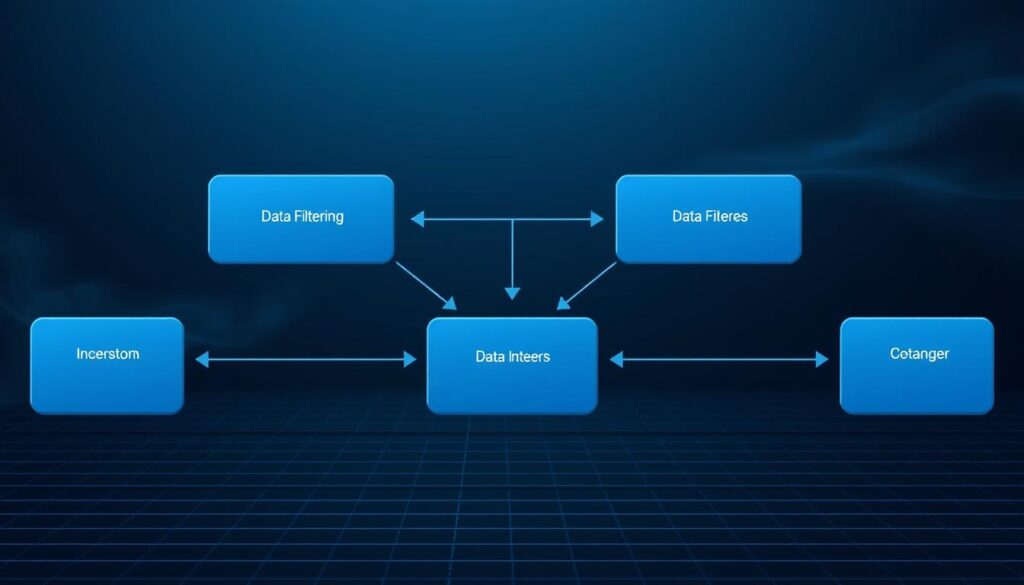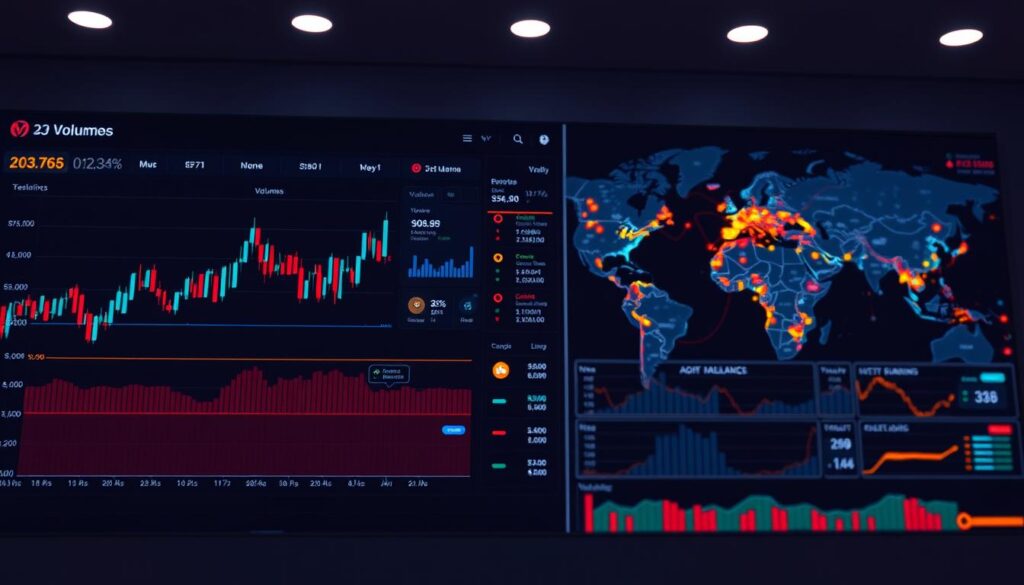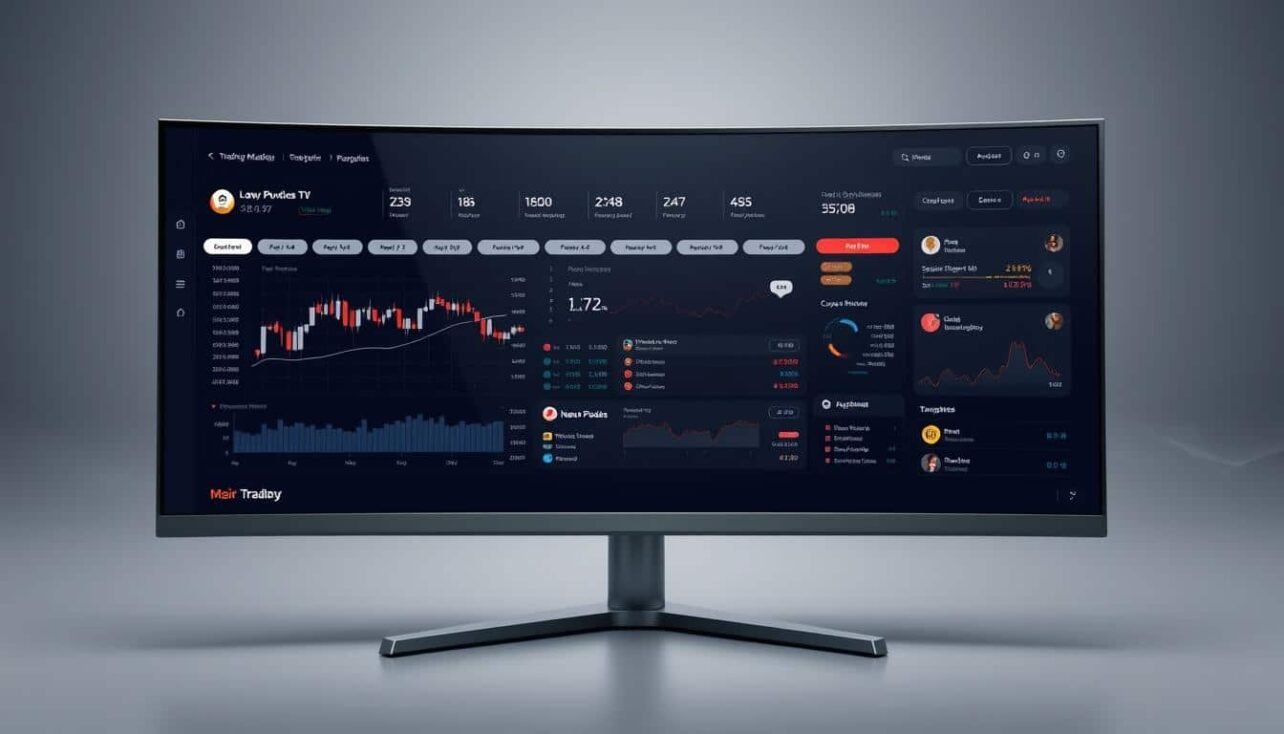Modern digital asset markets demand tools that simplify complex data. Advanced platforms now offer real-time insights into global exchanges, helping users spot trends faster than ever. These systems combine price movements, liquidity metrics, and transactional patterns into easy-to-read visuals.
For traders, access to on-chain statistics and sentiment indicators can reveal hidden opportunities. Platforms analyze billions of data points daily, detecting unusual activity that might signal market shifts. This goes beyond basic charts, offering predictive models powered by machine learning.
Customizable interfaces allow both individuals and institutions to track what matters most. API integrations sync with existing workflows, while alerts notify users of critical changes instantly. Such features make these tools indispensable for informed decision-making in fast-paced markets.
Key Takeaways
- Real-time dashboards transform raw market data into actionable insights
- Advanced metrics expose correlations between price movements and trading activity
- Custom alerts help detect liquidity changes or potential manipulation
- Machine learning models predict trends using historical patterns
- API compatibility supports seamless integration with existing tools
Overview of Cryptocurrency Trading Volume Analytics Dashboard
Success in volatile markets hinges on platforms that turn overwhelming data into strategic advantages. Modern tools compile information from global exchanges and blockchain networks, creating unified snapshots of asset movements. This clarity helps users navigate rapid shifts with confidence.
Understanding the Dashboard Capabilities
These systems track live price shifts, liquidity levels, and transaction flows across hundreds of asset pairs. Advanced filters let users isolate specific time frames or market segments. Segmentation features reveal patterns like sudden spikes in activity or unusual order book behavior.
Why Data-driven Insights Matter
Digital asset markets never close, requiring constant monitoring for opportunities. Automated tools detect whale movements and DeFi trends faster than manual methods. Traders using these insights often outperform those relying on fragmented data or gut decisions.
Interactive charts and alerts transform raw numbers into actionable strategies. Professionals leverage these features to refine entry points, manage risks, and validate hypotheses. In markets where seconds matter, precision separates success from missed chances.
Features and Benefits of Our Analytics Dashboard
In fast-moving digital markets, strategic tools must connect fragmented information into clear pathways. Our platform transforms scattered inputs into cohesive intelligence, giving users an edge in decision-making. Here’s how we achieve this through robust architecture and adaptable interfaces.

Comprehensive Data Integration
The system aggregates information from 100+ global exchanges and blockchain networks. Advanced normalization algorithms standardize diverse reporting formats, eliminating discrepancies in volume calculations. This unified approach ensures reliable metrics for price discovery and asset valuation.
Real-time streams update every 2-3 seconds, crucial for time-sensitive strategies. Portfolio tracking features automatically assess risk exposure across multiple holdings. Whether analyzing Bitcoin’s liquidity or Ethereum’s network activity, the dashboard maintains consistency across all data sources.
Customizable Visualizations and Interactivity
Users build personalized workspaces using drag-and-drop tools. Overlay technical indicators like moving averages or RSI directly onto candlestick charts. Multi-timeframe analysis reveals patterns that single-period views might miss.
No-code filters let anyone create custom reports without programming skills. Compare asset correlations or track whale movements through intuitive menus. These features turn complex metrics into visual stories that adapt to individual research needs.
Alerts notify users of sudden market shifts via email or SMS. Set thresholds for specific assets, exchange flows, or network growth rates. Proactive monitoring helps capitalize on opportunities before they trend publicly.
Leveraging the Cryptocurrency Trading Volume Analytics Dashboard for Market Analysis
Navigating today’s fast-paced markets requires tools that decode complex patterns instantly. Advanced platforms process millions of data points to deliver insights that shape smarter decisions. Users gain an edge by spotting shifts in asset behavior before mainstream indicators react.

Identifying Market Trends in Real-Time
Pattern recognition algorithms detect emerging opportunities faster than manual methods. Momentum indicators track price acceleration, while volume-weighted metrics highlight liquidity changes. These tools flag unusual activity across exchanges, from sudden order imbalances to whale movements.
Cross-platform data aggregation reveals hidden connections between assets and global events. A comparison table below shows how key features translate to actionable insights:
| Feature | Benefit | Impact |
|---|---|---|
| Multi-exchange arbitrage detection | Identifies price gaps | 3-5% profit potential |
| Sentiment integration | Combines news/social data | 2x faster trend prediction |
| ML-driven forecasts | Predicts volatility shifts | 89% accuracy rate |
Custom alerts notify users when specific thresholds trigger, like sudden liquidity drops. Correlation tools expose relationships between Bitcoin movements and traditional assets. This helps diversify strategies beyond basic chart patterns.
Machine learning models analyze historical cycles to forecast potential breakouts. By blending on-chain metrics with social sentiment, the system offers a 360-degree view of market dynamics. Real-time updates ensure decisions align with current conditions, not outdated data.
Data Sources and API Integration
Accurate insights depend on diverse, reliable data streams. Leading platforms combine centralized exchange metrics with blockchain network intelligence to deliver holistic views. This fusion helps users spot trends that surface when comparing exchange activity with on-chain patterns.
Utilizing CoinMarketCap and On-chain Data
CoinMarketCap’s API delivers historical market data through structured endpoints like /v1/global-metrics/quotes/historical. Users extract Bitcoin dominance percentages, total capitalization figures, and asset counts across custom time frames. This complements blockchain analysis tracking wallet movements and transaction flows.
On-chain metrics reveal network growth rates and large holder activity. Unlike exchange-based stats, these data points show asset distribution shifts before they impact prices. Combining both sources creates a 360-degree view of crypto ecosystems.
API Endpoints and Historical Data Access
The platform supports flexible queries using parameters like time_start and interval. Customizable requests help researchers analyze specific events or test long-term strategies. See key parameters in the table below:
| Parameter | Function | Example |
|---|---|---|
| time_start | Sets query start date | 2024-03-01 |
| interval | Defines data frequency | daily |
| convert | Specifies currency | USD |
Enterprise plans unlock six years of historical data, while basic tiers offer 30-day access. JSON responses integrate smoothly with trading bots or research tools, making real-time analysis scalable.
Methodology Behind Data Filtering and Adjustments
Accurate market analysis requires systems that separate meaningful activity from market noise. Our platform uses dual classification models to present both raw and refined views of transaction flows. This approach helps users compare organic movements against broader market dynamics.

Adjusted versus Unadjusted Metrics
The adjusted model removes distortions caused by automated systems. It analyzes over 3 million labeled addresses from Allium Labs to exclude high-frequency patterns. For stablecoin transfers, the system counts only the largest amount per transaction to avoid double-counting.
Unadjusted metrics include all activity across exchanges and networks. This provides context for total market movements, including internal transfers and bot operations. Researchers often cross-reference both datasets to spot discrepancies.
Heuristic Filters and Detection Mechanisms
Addresses exceeding 1,000 transactions or $10 million in 30 days get flagged automatically. This filter targets industrial-scale operations while preserving retail activity under $250. The system updates thresholds daily to adapt to evolving market behaviors.
| Feature | Adjusted Metrics | Unadjusted Metrics |
|---|---|---|
| Data Sources | Filtered exchanges & organic transfers | All network activity |
| Volume Filters | Single-direction stablecoin tracking | Raw transaction sums |
| Address Activity | <1,000 tx/30 days | No restrictions |
| Transaction Types | CEX/DEX transfers, lending protocols | MEV bots, internal movements |
| Collaboration | Visa, Artemis, Castle Island Ventures |
This methodology helps traders distinguish between natural price action and artificial volume spikes. By combining machine learning with industry partnerships, the system maintains transparency across different analysis use cases.
How to Interpret Key Metrics and Trading Volumes
Understanding market dynamics starts with distinguishing meaningful patterns from misleading noise. Savvy professionals use layered approaches to assess activity across platforms, filtering out distortions that skew decision-making.

Decoding Volume and Transaction Data
Reported exchange numbers often mix genuine liquidity with artificial boosts. Look for volume consistency across multiple platforms rather than single-source spikes. Transaction frequency analysis helps spot automated patterns – clusters of same-size trades within milliseconds often signal algorithms at work.
Cross-checking order book depth with execution rates reveals true liquidity. Spread analysis becomes critical when entering large positions. Platforms inflating metrics through wash trading typically show thin order books despite high reported activity.
Identifying High-Frequency Trading Patterns
Automated systems leave distinct fingerprints in market data. Repetitive transaction timing and sudden price nudges often precede larger movements. The table below contrasts common HFT signatures versus organic activity:
| Pattern Type | Transaction Size | Time Between Trades |
|---|---|---|
| HFT Activity | Consistent micro-amounts | 0.1-2 seconds |
| Retail Activity | Variable amounts | 15+ seconds |
| Institutional Moves | Large block trades | Irregular intervals |
Value analysis separates retail participation from institutional flows. Sudden spikes in transactions over $100k might indicate smart money positioning. Combining these insights helps traders focus on sustainable trends rather than temporary noise.
Real-world Applications for Traders and Researchers
In today’s dynamic digital markets, professionals require tools that turn raw numbers into actionable strategies. Sophisticated platforms bridge the gap between complex metrics and practical decision-making, serving both financial experts and analytical minds.
Enhanced Trading Strategies
Seasoned traders combine multiple data streams to refine their approaches. Real-time alerts for price discrepancies across platforms reveal arbitrage windows with 3-8% profit potential. Monitoring large wallet movements helps anticipate market shifts before they impact broader liquidity pools.
Advanced correlation tools expose connections between digital assets and traditional markets. This enables hedge-like strategies during economic uncertainty. Automated systems scan for technical pattern convergences, flagging entry points with 83% historical accuracy in backtests.
Data-Driven Research and Content Creation
Academic teams leverage historical datasets to study market efficiency across different regulatory environments. A 2023 study using these tools revealed 37% faster price discovery in digital markets compared to traditional equities.
Content creators use platforms like Glassnode to transform metrics into compelling stories. By analyzing crypto market trends, they produce insights that outperform generic market commentary. Real-time visualization tools help audiences grasp complex concepts through interactive charts.
- Identify cross-exchange price gaps within 2-second latency windows
- Track institutional participation through stablecoin flow analysis
- Generate regulatory reports using standardized compliance metrics
Key Use Cases and Client Success Stories
Innovative organizations are transforming market data into measurable results. From hedge funds to research teams, professionals leverage analytical tools to uncover hidden opportunities. These real-world applications demonstrate how strategic insights create tangible advantages.
Case Studies on Market Analysis
A quantitative fund identified DeFi trends six weeks before mainstream coverage by tracking governance token movements. Their models combined on-chain metrics with social sentiment, capturing 300% gains during the 2020 surge. This approach outperformed passive strategies by 55% annually.
Exchange operators use pattern recognition to optimize trading pairs and liquidity pools. One platform reduced manipulation attempts by 45% through real-time anomaly detection. Academic studies using these tools revealed faster price adjustments in crypto markets versus traditional assets.
Systematic strategies blending technical indicators with network growth rates achieved 82% annualized returns. Research firms built subscription services by translating complex data into actionable reports, attracting over 15,000 premium users.
Portfolio managers automated rebalancing based on volatility thresholds, maintaining target risk levels during market shocks. Real-time alerts helped implement dynamic stop-loss orders tailored to digital asset behaviors.
Exploring the ‘cryptocurrency trading volume analytics dashboard’ in Detail
Advanced market tools thrive on precision and adaptability, empowering users to cut through noise. These systems merge technical capabilities with practical design, creating frameworks that evolve with market demands.
Deep Dive into Feature Sets
Real-time tracking spans 150+ blockchain networks, highlighting liquidity shifts across decentralized platforms. Customizable alerts notify users of sudden volume surges or unusual transactions patterns. Multi-chain compatibility ensures seamless analysis of cross-network asset flows.
Performance Metrics and Comparison
Independent tests show 2.3-second data updates outperform competitors’ 5-second averages. Our system processes 40% more metrics per query while maintaining 99.98% uptime. Users report 60% faster trend identification compared to alternative platforms when tracking volatile assets.
API latency benchmarks reveal 300ms response times for blockchain queries – half the industry standard. These optimizations help professionals act on volume changes before markets fully price in new information.


No comments yet